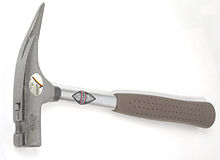Carpenter hammer
The claw hammer or Zimmerer hammer , also Latthammer is a hammer for use in the timber , this has on one side a nail path, on the other hand, a claw for pulling nails. In Europe, carpenter's hammers are used that have a claw tooth as a tip; this can be hammered into wood in order to move heavy purlins and rafters safely.
The surface of the hammer track on hammer hammers is often ribbed to prevent it from slipping off the nail heads . Special hammers for demoulding work have a smooth track.
In addition to timber construction, carpenter's hammers are also used in formwork construction.
Form and function
The main difference between the carpenter's hammer and other hammers is its asymmetrical claw. If other hammers have the fin to hammer small areas, the claw is used to pull nails, similar to a small cow's foot, and to hammer into wood. In order to move very heavy wooden components that are difficult to grasp (e.g. a purlin that rests completely on a support), the tip can be hammered into the workpiece , similar to a sapie , and the carpenter's hammer serves as a handle. Since wood construction often involves working in positions where one hand is needed to hold on, the carpenter's hammer can be hammered into the wood to have the other hand free.
In addition to the track and the claw, the carpenter's hammer has a trough-shaped part with a wedge slot , the nail lifter . It is used for lifting, i.e. pulling out nails. With large nails it is advisable to use an ax in addition to the carpenter's hammer.
For nailing overhead or in hard-to-reach places where the nail points cannot be reached with both hands, some hammer tracks are provided with a magnetic nail holder. This eliminates the need for a second hand to initially hold the nail. The iron nail, on the other hand, is placed in the groove formed above the track with a recess and stop for the head and is held there sufficiently by a sunk-in permanent magnet to be driven into the wood with a rather gentle hammer blow. The train then continues. For wrapping large nails (rafter nails and the like) is usually an ax or a sledge used; these have a longer handle and a heavier head than the carpenter's hammer and thus achieve a much higher impact pulse .
A carpenter typically carries a carpenter's hammer in a hammer loop or tool chain that is attached to the belt (belt) while working.
Carpenter's hammers are available in different designs: with a wooden, plastic or tubular steel handle or with a forged handle. The shapes with wooden or tubular steel handles are defined in DIN standard 7239 - roofing hammers.
Web links
See also
Individual evidence
- ^ A b Franz Krämer: Basic knowledge of the carpenter. Bruderverlag, Karlsruhe 1982, ISBN 3-87104-052-5


